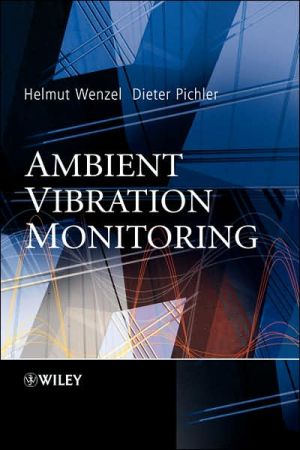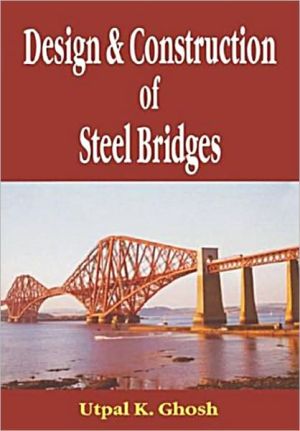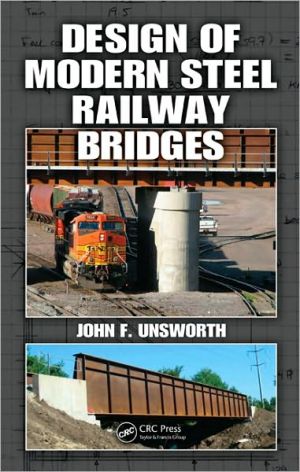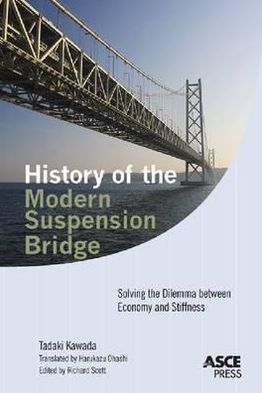Ambient Vibration Monitoring
In-operation vibration monitoring for complex mechanical structures and rotating machines is of key importance in many industrial areas such as aeronautics (wings and other structures subject to strength), automobile (gearbox mounting with a sports car body), rail transportation, power engineering (rotating machines, core and pipes of nuclear power plants), and civil engineering (large buildings subject to hurricanes or earthquakes, bridges, dams, offshore structures). Tools for the detection...
Search in google:
In-operation vibration monitoring for complex mechanical structures and rotating machines is of key importance in many industrial areas such as aeronautics (wings and other structures subject to strength), automobile (gearbox mounting with a sports car body), rail transportation, power engineering (rotating machines, core and pipes of nuclear power plants), and civil engineering (large buildings subject to hurricanes or earthquakes, bridges, dams, offshore structures). Tools for the detection and the diagnosis of small changes in vibratory characteristics are particularly useful to set up a preventive maintenance policy based on the actual evolution of the state of the monitored machine or structure, as opposed to systematic a priori planning. Ambient Vibration Monitoring is the backbone of such structural assessment monitoring and control. It provides the possibility to gain useful data under ambient conditions for the assessment of structures and components. Written by a widely respected authority in this area, Ambient Vibration Monitoring describes the current practice of ambient vibration methodologies illustrated by a number of practical examples. Designed to aid the practical engineer with their understanding of the topic, it is the culmination of many years of practical research and includes numerous ‘real world’ examples. It also provides information on applicable solutions. This book will enable not only practitioners (in civil, mechanical and aerospace engineering), but also researchers and students, to learn more about the theory and practical applications of this subject.
Ambient Vibration Monitoring\ \ By Helmut Wenzel \ John Wiley & Sons\ Copyright © 2005 John Wiley & Sons, Ltd\ All right reserved. \ ISBN: 0-470-02430-5 \ \ \ Chapter One\ Introduction \ The increasing number of civil engineering structures in the field of traffic infrastructure entails the increasing significance of maintenance problems of such engineering structures. Bridges are monitored by periodic supervision measures with the aim of minimizing the safety risk for the user, on the one hand, and of keeping the costs for the maintenance as low as possible by the execution of rehabilitation measures at the right time, on the other hand.\ Potential Impact\ Civil engineers concerned with supervision of structures for safety and maintenance reasons are aware of the limitations of their current practice of condition assessment based on visual inspections. Typical routine applications of condition assessment are carried out on structures applying rating systems. The consequence would be unbearable costs on society for replacement and retrofit tightened up by shrinking budgets. The expressed intention of the bridge owners globally is to reduce the number of bridges rated deficient by 30% within a short time through the application of sophisticated methods based on measurements.\ 1.1 SCOPE OF APPLICATIONS\ Owing to the quickly increasing traffic density, in particular in the field of sophisticated road networks, restrictions of unhindered traffic flow because of inspection works entail high economic costs. Therefore such works must be limited to the absolutely necessary minimum. The ambient vibration method (AVM) was developed under the premise that it can be used practically without any impairment of the traffic flow. The aim is to provide a system that makes it possible to reduce the employment of inspection devices to a minimum by wellaimed specification of problem zones, therefore maintaining the traffic flow in as undisturbed a way as possible during inspection works. The procedure can be applied independently of the type and construction of the structure and materials used.\ The currently used procedures for bridge monitoring are dominated by manual methods. Visual assessments have a central significance. Devices such as binoculars, magnifying glass for measuring, levelling instruments, endoscopes, etc., are used but the results are dependent on the subjective recognition of damage by the personnel carrying out the examination. It is tried to objectify the recognition by check lists, comparative patterns, etc. Additional methods such as concrete cover measurements and chemically and technical tests help to document an objective image of the maintenance condition.\ The AVM has an engineering character comparable with the main manual inspection methods currently used. By measuring the vibration behaviour 'actual' values are obtained, which - with certain restrictions - are not subject to the circumstances of the personnel carrying out the test. The objective condition of the tested structure is determined by a systematic analytical evaluation.\ Of course the methods used formerly do not become obsolete but rather provide an additional assessment procedure that improves the application of the method. The examples presented in this report show how AVM can be usefully applied for the support of traditional methods of bridge monitoring. Apart from the requirements for bridge and structure monitoring AVM offers an abundance of further areas of application, which owing to its flexibility are also explained by means of practical examples.\ 1.2 LAWS AND REGULATIONS\ In Austria, according to the relevant legal regulations (federal road law, provincial road administrative laws, building regulations for Vienna), the road administration is responsible for road building and road maintenance. The competent road administration is therefore also responsible for the safety of the engineering buildings in the course of its road network. This results in the following competencies for the Austrian road network:\ federal road network: the provincial governors by way of the indirect federal administration, special companies (OSAG, ASAG);\ provincial road network: the provincial governments, the district administration authorities, the mayors.\ With regard to road construction and road maintenance no special legal regulations exist. Roads and therefore road bridges have to be built and maintained according to the respective state of the art.\ In Austria bridge monitoring in the field of the federal road network takes place on the basis of RVS 13.71, Strassenerhaltung - Uberwachung, Kontrolle und Prufung - Strassenbrucken (road maintenance - monitoring, inspection and check - road bridges) at periodic intervals [1]. Here four types of monitoring are distinguished:\ constant monitoring;\ inspection;\ check;\ special test.\ Constant monitoring includes the determination of damages that are discernible from outside and is carried out by inspection rides at least every four months. Inspections take place at least every two years with an increased examination depth for the substructure and superstructure by means of a checklist compared with constant monitoring, but usually no special devices are used for it.\ The checks (also bridge checks or main checks) are, however, usually carried out every six years. For these checks bridge inspection devices are often used, which frequently require a partial road block. Special tests are carried out if a survey of the actual condition is required due to special events (e.g. after an accident). The scope of such tests corresponds to that of a regular main check; traffic restrictions therefore occur in a similar scope.\ In Germany the decisive standard in this field is the DIN 1076, which is valid both for railway and for road bridges. This standard was globally introduced for road construction in all German Federal States in November 1999. For the German railways the D804 with various modules is valid for bridges and other civil engineering structures. They are, however, still being revised at the time of preparation of this publication. In particular, the D80480 is decisive for inspections and/or examinations but must be adapted to the new module system.\ In France the decisive standards were published by the Division of Road Management in the Transport Ministry. They are generally known under the title Technical Instructions for the Supervision and Maintenance of Engineering Structures. What has to be pointed out is in particular fascicle 31 in part II (1990): Reinforced and Unreinforced Concrete Bridges, as well as fascicle 32 (1986): Prestressed Concrete Bridges. Fascicle 34 (1986) refers to Steel Bridges.\ Furthermore, a regulation on the 'Classification of Structures' from 1996 as well as numerous publications and leaflets by LCPC (Laboratoire Central des Ponts et Chaussees), a governmental research institute dealing with building and infrastructure as well as town planning and environmental technology, are decisive. The following titles were analogously translated from French:\ Handbook for the Identification and Interpretation of Reactions and Signs of Concrete Damages (Fatigue) in Engineering Structures, LCPC (1998);\ Examination of Cable Forces by Using Vibration Measurements, LCPC (1993).\ In Italy the decisive standards were published by the Ministry for Public Works (Ministero Lavori Pubblici) in 1971 and 1974. In particular the technical standards for the planning, execution and final approval of road bridges (Norme tecniche per la progettazione, la esecuzione e il collaudo dei ponti stradali) need to be mentioned, which were revised and complemented in 1991.\ In Great Britain the decisive standards are basically divided into four groups: inspection, maintenance, repair and strengthening, and assessment of roads and bridges. In particular the codes of practice in section one (inspection), including inspection of highway structures and of post-tensioned concrete bridges, as well as inspection and records for road tunnels, and in section four (assessment), assessment of steel, concrete and composite bridges, are interesting.\ In this connection the following leaflets as well as a German standard draft are interesting as important aids:\ Automatisierte Daueruberwachung im Ingenieurbau, Merkblatt des DGZfp-Ausschuss fur zerstorungsfreie Prufung im Bauwesen (AB), dated 12 August 1997;\ Zustandsanalyse mittels modaler Analyse (ZMA) Merkblatt des DGZfp-Ausschuss fur zerstorungsfreie Prufung im Bauwesen (AB), dated March 1998;\ ISO/CD 14963, Mechanical Vibration and Shock - Guidelines for Dynamic Test and Investigation on Bridges and Viaducts, from DIN-Normen Ausschuss Bauwesen, dated 12 October 1999.\ This standard is to form the regulation on which dynamic bridge monitoring will be based in the future.\ Standardization is to be established at a uniform level all over Europe by means of the European network project SAMCO (structural assessment monitoring and control, project number CTG2-2000-33069 of the DG Research of the European Union). This is to be the prerequisite for a quick dissemination of dynamic methods. The progress of the project, which was started in 2001, can be followed under samco.org on the Internet.\ 1.3 THEORIES ON THE DEVELOPMENT OF THE AVM\ The AVM is a practice-oriented procedure that closes the gap between basic research and application-oriented development by means of statistical methods and approximation methods. Therefore the following assumptions are made:\ The condition of a structure represents itself in the response spectrum.\ The linear static and linear dynamic approaches are not sufficient for describing correctly the dynamic characteristic mathematically.\ The measuring technique has been sufficiently developed.\ Data acquisition and evaluation via computers is efficiently feasible.\ The existing software is appropriate for meeting the requirements.\ From the preceding assessment of the status quo the following results can be derived:\ The measuring technique is widely advanced and the data will be lasting.\ The theoretical evaluation can still be developed further.\ The aim of this work is to close this gap by an empirical solution that will last until computer mechanics is in a position to supply sufficiently reliable results. The following theory, which is represented in a simplified way here, arises from this fact:\ The gap between measuring technology and calculation can be closed by simple statistic, empiric procedures based on probability.\ The basic idea is to register the dynamic characteristic by means of the highly sensitive acceleration sensors and to measure absolute deformation values by means of a laser in parallel and simultaneously. The correlation of the two signals calibrates the measurement. The error arising from this can be estimated, but does not have any influence on the quality of the interpretation. This method can be replaced by more accurate interpretation procedures as soon as the required non-linear calculation methods are ready for application. The measurements are, however, so precise that they can offer reference data with a high qualitative value for every future evaluation method.\ It is therefore justified to begin with periodic measurements of structures now, even if the tools for a more detailed analytical solution are not yet available. The empirical procedure already yields excellent results.\ A classification of structures with a similar design is possible and can be used as the basis for a sequence of priorities. In Figure 1.1 the measuring results of 35 small pre-stressed concrete bridges, which were built between 1955 and 1965, are shown. The condition of the structures is reflected in the measuring values and therefore clearly shows the need for action.\ (Continues...)\ \ \ \ \ Excerpted from Ambient Vibration Monitoring by Helmut Wenzel Copyright © 2005 by John Wiley & Sons, Ltd. Excerpted by permission.\ All rights reserved. No part of this excerpt may be reproduced or reprinted without permission in writing from the publisher.\ Excerpts are provided by Dial-A-Book Inc. solely for the personal use of visitors to this web site. \ \
PREFACE. ACKNOWLEDGEMENTS. SUMMARY. 1 INTRODUCTION. 1.1 Scope of Applications. 1.2 Laws and Regulations. 1.3 Theories on the Development of the AVM. 2 OBJECTIVES OF APPLICATIONS. 2.1 System Identification. 2.1.1 Eigenfrequencies and Mode Shapes. 2.1.2 Damping. 2.1.3 Deformations and Displacements. 2.1.4 Vibration Intensity. 2.1.5 Trend Cards. 2.2 Stress Test. 2.2.1 Determination of Static and Dynamic Stresses. 2.2.2 Determination of the Vibration Elements. 2.2.3 Stress of Individual Structural Members. 2.2.4 Determination of Forces in Tendons and Cables. 2.3 Assessment of Stresses. 2.3.1 Structural Safety. 2.3.2 Structural Member Safety. 2.3.3 Maintenance Requirements and Intervals. 2.3.4 Remaining Operational Lifetime. 2.4 Load Observation (Determination of External Influences). 2.4.1 Load Collective. 2.4.2 Stress Characteristic. 2.4.3 Verification of Load Models. 2.4.4 Determination of Environmental Influences. 2.4.5 Determination of Specific Measures. 2.4.6 Check on the Success of Rehabilitation Measures. 2.4.7 Dynamic Effects on Cables and Tendons. 2.4.8 Parametric Excitation. 2.5 Monitoring of the Condition of Structures. 2.5.1 Assessment of Individual Objects. 2.5.2 Periodic Monitoring. 2.5.3 BRIMOS_ Recorder. 2.5.4 Permanent Monitoring. 2.5.5 Subsequent Measures. 2.6 Application of Ambient Vibration Testing to Structures for Railways. 2.6.1 Sleepers. 2.6.2 Noise and Vibration Problems. 2.7 Limitations. 2.7.1 Limits of Measuring Technology. 2.7.2 Limits of Application. 2.7.3 Limits ofAnalysis. 2.7.4 Perspectives. References. 3 FEEDBACK FROM MONITORING TO BRIDGE DESIGN. 3.1 Economic Background. 3.2 Lessons Learned. 3.2.1 Conservative Design. 3.2.2 External versus Internal Pre-stressing. 3.2.3 Influence of Temperature. 3.2.4 Displacement. 3.2.5 Large Bridges versus Small Bridges. 3.2.6 Vibration Intensities. 3.2.7 Damping Values of New Composite Bridges. 3.2.8 Value of Patterns. 3.2.9 Understanding of Behaviour. 3.2.10 Dynamic Factors. References. 4 PRACTICAL MEASURING METHODS. 4.1 Execution of Measuring. 4.1.1 Test Planning. 4.1.2 Levelling of the Sensors. 4.1.3 Measuring the Structure. 4.2 Dynamic Analysis. 4.2.1 Calculation Models. 4.2.2 State of the Art. 4.3 Measuring System. 4.3.1 BRIMOS<sup>®</sup>. 4.3.2 Sensors. 4.3.3 Data-Logger. 4.3.4 Additional Measuring Devices and Methods. 4.4 Environmental Influence. 4.5 Calibration and Reliability. 4.6 Remaining Operational Lifetime. 4.6.1 Rainflow Algorithm. 4.6.2 Calculation of Stresses by FEM. 4.6.3 S–N Approach and Damage Accumulation. 4.6.4 Remaining Service Lifetime by Means of Existing Traffic Data and Additional Forward and Backward Extrapolation. 4.6.5 Conclusions and Future Work. References. 5 PRACTICAL EVALUATION METHODS. 5.1 Plausibility of Raw Data. 5.2 AVM Analysis. 5.2.1 Recording. 5.2.2 Data Reduction. 5.2.3 Data Selection. 5.2.4 Frequency Analysis, ANPSD (Averaged Normalized Power Spectral Density). 5.2.5 Mode Shapes. 5.2.6 Damping. 5.2.7 Deformations. 5.2.8 Vibration Coefficients. 5.2.9 Counting of Events. 5.3 Stochastic Subspace Identification Method. 5.3.1 The Stochastic Subspace Identification (SSI) Method. 5.3.2 Application to Bridge Z24. 5.4 Use of Modal Data in Structural Health Monitoring. 5.4.1 Finite Element Model Updating Method. 5.4.2 Application to Bridge Z24. 5.4.3 Conclusions. 5.5 External Tendons and Stay Cables. 5.5.1 General Information. 5.5.2 Theoretical Bases. 5.5.3 Practical Implementation. 5.5.4 State of the Art. 5.5.5 Rain–Wind Induced Vibrations of Stay Cables. 5.5.6 Assessment. 5.6 Damage Identification and Localization. 5.6.1 Motivation for SHM. 5.6.2 Current Practice. 5.6.3 Condition and Damage Indices. 5.6.4 Basic Philosophy of SHM. 5.7 Damage Prognosis. 5.7.1 Sensing Developments. 5.7.2 Data Interrogation Procedure for Damage Prognosis. 5.7.3 Predictive Modelling of Damage Evolution. 5.8 Animation and the Modal Assurance Criterion (MAC). 5.8.1 Representation of the Calculated Mode Shapes. 5.8.2 General Requirements. 5.8.3 Correlation of Measurement and Calculation (MAC). 5.8.4 Varying Number of Eigenvectors. 5.8.5 Complex Eigenvector Measurement. 5.8.6 Selection of Suitable Check Points using the MAC. 5.9 Ambient Vibration Derivatives (AVD<sup>®</sup>). 5.9.1 Aerodynamic Derivatives. 5.9.2 Applications of the AVM. 5.9.3 Practical Implementation. References. 6 THEORETICAL BASES. 6.1 General Survey on the Dynamic Calculation Method. 6.2 Short Description of Analytical Modal Analysis. 6.3 Equation of Motion of Linear Structures. 6.3.1 SDOF System. 6.3.2 MDOF System. 6.3.3 Influence of Damping. 6.4 Dynamic Calculation Method for the AVM. 6.5 Practical Evaluation of Measurements. 6.5.1 Eigenfrequencies. 6.5.2 Mode Shapes. 6.5.3 Damping. 6.6 Theory on Cable Force Determination. 6.6.1 Frequencies of Cables as a Function of the Inherent Tensile Force. 6.6.2 Influence of the Bending Stiffness. 6.6.3 Influence of the Support Conditions. 6.6.4 Comparison of the Defined Cases with Experimental Results. 6.6.5 Measurement Data Adjustment for Exact Cable Force Determination. 6.7 Transfer Functions Analysis. 6.7.1 Mathematical Backgrounds. 6.7.2 Transfer Functions in the Vibration Analysis. 6.7.3 Applications (Examples). 6.8 Stochastic Subspace Identification. 6.8.1 Stochastic State-Space Models. 6.8.2 Stochastic System Identification. References. 7 OUTLOOK. 7.1 Decision Support Systems. 7.2 Sensor Technology and Sensor Networks. 7.2.1 State-of-the-Art Sensor Technology. 7.3 Research Gaps and Opportunities. 7.4 International Collaboration. 7.4.1 Collaboration Framework. 7.4.2 Activities. 8 EXAMPLES FOR APPLICATION. 8.1 Aitertal Bridge, Post-tensional T-beam (1956). 8.2 Donaustadt Bridge, Cable-Stayed Bridge in Steel (1996). 8.3 F9 Viaduct Donnergraben, Continuous Box Girder (1979). 8.4 Europa Bridge, Continuous Steel Box Girder (1961). 8.5 Gasthofalm Bridge, Composite Bridge (1979). 8.6 Kao Ping Hsi Bridge, Cable-Stayed Bridge (2000). 8.7 Inn Bridge Roppen, Concrete Bridge (1936). 8.8 Slope Bridge Saag, Bridge Rehabilitation (1998). 8.9 Flyover St Marx, Permanent Monitoring. 8.10 Mur Bridge in St Michael, Bridge Rehabilitation. 8.11 Rosen Bridge in Tulln, Concrete Cable-Stayed Bridge (1995). 8.12 VOEST Bridge, Steel Cable-Stayed Bridge (1966). 8.13 Taichung Bridge, Cable-Stayed Bridge. APPENDIX. Nomenclature. INDEX.








